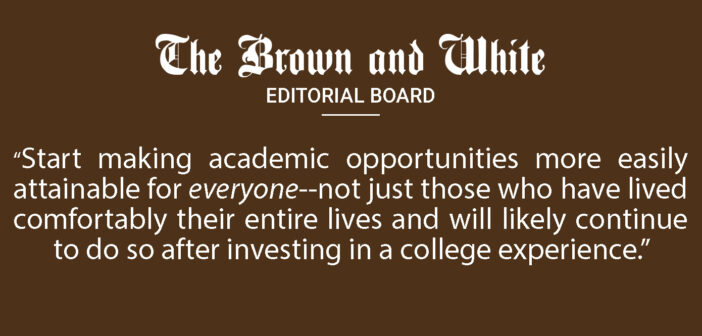Reflecting back on high school, what one big thing was on all of our minds? For many students, the answer comes immediately, in the form of two daunting words: college applications.
Many students learn that attending college is the natural next big step to take after earning a high school diploma.
By now we know that this isn’t always realistic—not only is college costly, but the application process is also prohibitively expensive.
Tutors, textbooks, AP exams, SAT and ACT testing fees… , even the opportunity costs necessary to get a certain grade or score and not to mention the college application itself; it all has a price tag which not everyone can afford.
In other words, a number of prestigious institutions are being sued for allegedly working together through a shared formula used to calculate the financial need of applicants and thus limit or eliminate financial aid packages provided to students, despite their “need-blind” admissions system.
As a result, thousands of students have been overcharged for their education.
Those accused include Brown University, the California Institute of Technology, the University of Chicago, Columbia University, Cornell University, Dartmouth College, Duke University, Emory University, Georgetown University, the Massachusetts Institute of Technology, Northwestern University, University of Notre Dame, the University of Pennsylvania, Rice University, Vanderbilt University and Yale University.
There are barriers when it comes to higher education to begin with, and these practices make it even more inaccessible
Over the past two decades, college tuition has increased in price more than any other good or service besides hospital care. College tuition has more than doubled since the turn of the century.
Not to mention, Dr. Jill Biden recently confirmed free community college on a national basis is no longer on the table despite it being one of the major pieces of President Joe Biden’s Build Back Better agenda.
While fingers point to increased spending on administrators, overbuilding of campus amenities and the easy availability of subsidized student loans, the fact of the matter is that these tuition-increasing practices persist because higher education institutions are not fully transparent about their true prices.
When we think of colleges and universities, we view them as academic institutions. Yet, at the end of the day, they’re all businesses. Higher education prioritizes the money they’re making over the students they’re educating—oftentimes private institutions find themselves more prone to this.
Remember Operation Varsity Blues, the 2019 federal investigation that caught dozens of parents, coaches and exam coordinators in the midst of a college admissions scheme? The one that let the American public see how wealthy and well-connected donors could buy their children’s admission to college? Yeah, money talks.
As students of Lehigh, we periodically see money as a top priority—especially amid the pandemic, when money was being put towards the planning of large, in-person events for alumni and prospective students while campus resources struggled to meet the needs of current students.
Regardless of what people think is the true reason behind increasing tuition costs, it is a fact that higher education is viewed by society as an important investment in one’s future.
Yet, less than half of Americans aged 25 and over have a college degree.
Sure, more and more schools today are becoming test optional, meaning that standardized test scores are not required for a student to be admitted. This is helpful for those who can’t afford test-prep or the exam fees themselves. However, are schools taking this step because they really have our interests in mind?
Regardless, this price-fixing lawsuit shined an even brighter light on one of the top concerns our education system has: money.
If our colleges and universities go so far as to make bold statements distinguishing themselves as “agents of change,” let’s see some real change.
Start making academic opportunities more easily attainable for everyone—not just those who have lived comfortably their entire lives and will likely continue to do so after investing in a college experience.
We’ll leave you with this: Prioritizing the wealthy and impeding the financially needy are two sides of the same coin. It’s time to do something about it.






Comment policy
Comments posted to The Brown and White website are reviewed by a moderator before being approved. Incendiary speech or harassing language, including comments targeted at individuals, may be deemed unacceptable and not published. Spam and other soliciting will also be declined.
The Brown and White also reserves the right to not publish entirely anonymous comments.
6 Comments
brilliant idea
Thank you for another thought provoking op-ed piece. How about a mandatory 2 years of paid government service after high school with 2 years of free college education and 2 years more of reduced cost education if desired. This kills two birds with one stone. College education and a stakeholders experience of our government. I have a feeling not many want to ever experience one of those birds in their lives.
“While fingers point to increased spending on administrators, overbuilding of campus amenities and the easy availability of subsidized student loans, the fact of the matter is that these tuition-increasing practices persist because higher education institutions are not fully transparent about their true prices.
When we think of colleges and universities, we view them as academic institutions. Yet, at the end of the day, they’re all businesses. Higher education prioritizes the money they’re making over the students they’re educating—oftentimes private institutions find themselves more prone to this.”
I don’t believe Lehigh “prioritizes the money they’re making over the students they’re educating” but Lehigh is a business and must be financially solvent. It is in competition with public institutions that probably have an easier time obtaining the almighty dollar.
The campus amenities may be an attempt or a necessity in obtaining “prime students”, however the university defines the meaning of that term. These amenities are not only physical entities but also service entities, whose providers require amenities of their own in addition to their salaries.
Use of some of the physical amenities may be limited to a select group but all students desire them. The service amenities may even be more desired because they’re ostensibly available to all students but typically can’t be fully used by all.
So although past Lehigh students, and I believe some current ones, were not thrilled living in a room the size of a jail cell, I’m assuming the cell size, they were able to live through it without temporary or permanent emotional scaring, the assumption here is for current dorm residents.
So the enhanced facilities and services promote higher costs and more students who cannot afford the cost promote higher costs for those who subsidize them and possibly greater debt besides.
“Start making academic opportunities more easily attainable for everyone” Lehigh has made a Lehigh education available to more people, a fact which undoubtedly should please those people but apparently not the editorial board at the B&W.
Public universities would be better places to lobby for “everyone”. It was my understanding that the PA state colleges had a space for almost everyone who applied but had exceedingly high attrition rates wherein a great majority of Lehigh students graduated. I think being selective is looked upon as a vice these days.
I have read the blog and found it interesting for me. I really think that I will get more like this in the future.
amazing ideaguys
nice idea